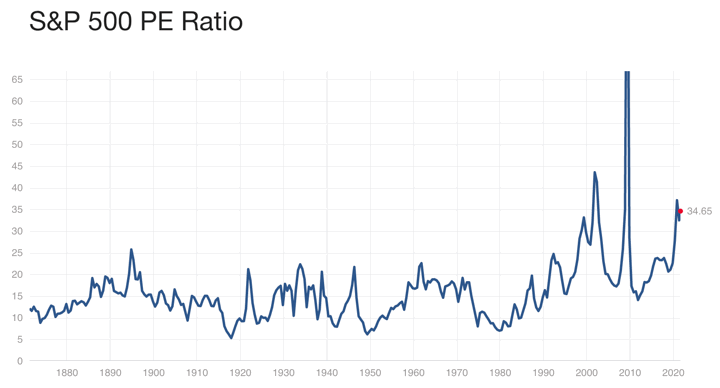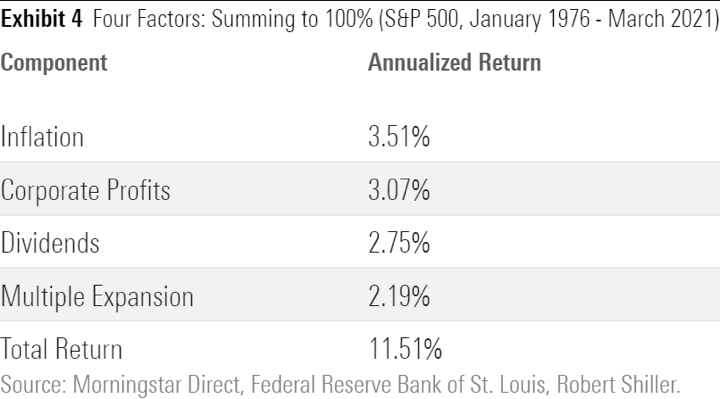According to Multpl.com, the P/E ratio of the S&P 500 is now 35, and the dividend yield is only 1.3%. The all-time low dividend yield was 1.11% back in August 2020. Even if you consider stock buybacks, the earnings yield is less than 3%! That means if corporations all distributed every penny of their profits as dividends, it still wouldn’t be higher than 3%. Before we go any further, I’m not advocating market timing, as people were saying that the S&P 500 was “overvalued” back in 2015 when the P/E ratio was 25 and the dividend yield was 2%. Nobody truly knows what will happen to prices in the short-term.

Even if the P/E ratio seems a lot higher now than the historical average, what has that actually meant? The Morningstar article How Much Has the Market Benefited from Investor Optimism? examines how much of the historical return of the S&P 500 from 1976 through March 2021 was from P/E expansion.

In January 1976, the P/E ratio was only 11.8. In March 2021, the P/E ratio was 31.5. That seems like a huge difference, and over that 45-year time period, it did add 2.2% to the overall historical average annual return. But we also got 3% from earning growth, and another 2.75% from dividends, for a total return of ~8% above inflation. 8% real return!
In a way, this is somewhat comforting, as if you look at the long-term, a shrinking P/E ratio won’t completely destroy your retirement by itself. Instead of adding 2%, it might subtract 2%.
Looking ahead, if you assume a generous 4% from earnings growth, 0% from a constant P/E ratio, and 1.3% from dividends, that’s roughly a 5% future real return. But if the P/E ratio goes back even partly back to historical averages, that will be closer to a 4% real return. The problem is that bonds are giving us 0% real return at best, so I’m sticking with owning productive businesses.
The numbers on my brokerage statements keep going up so perhaps I shouldn’t complain, but I sure hope the earnings start to catch up to the prices soon (as some predict). I like the idea of the P/E ratio going down due to higher earnings rather than lower prices!
 The Best Credit Card Bonus Offers – 2025
The Best Credit Card Bonus Offers – 2025 Big List of Free Stocks from Brokerage Apps
Big List of Free Stocks from Brokerage Apps Best Interest Rates on Cash - 2025
Best Interest Rates on Cash - 2025 Free Credit Scores x 3 + Free Credit Monitoring
Free Credit Scores x 3 + Free Credit Monitoring Best No Fee 0% APR Balance Transfer Offers
Best No Fee 0% APR Balance Transfer Offers Little-Known Cellular Data Plans That Can Save Big Money
Little-Known Cellular Data Plans That Can Save Big Money How To Haggle Your Cable or Direct TV Bill
How To Haggle Your Cable or Direct TV Bill Big List of Free Consumer Data Reports (Credit, Rent, Work)
Big List of Free Consumer Data Reports (Credit, Rent, Work)
This is really good data, Thanks Jonathan!
Doesn’t a higher going-in price also reduce those other factors? You’ve already pointed out that the dividend yield is lower. If earnings growth added 3% when you were “bought” the market for 12x earnings, don’t earnings have to grow nearly 2.5-3x faster when you “buy” the market for 32x earnings, in order to deliver that same 3%???
This only covers the United States though. Globally, I think there are better P/Es that can offer room for expansion going forward.
I agree, the US is more expensive in terms of P/E ratio than other countries right now. However, I read somewhere that the average US investor has very little global diversification. This may be another benefit of a good Target Retirement mutual fund that “nudges” people to hold some international exposure all the time.